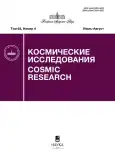Some features of the formation of absorbed dose behind thin shieldings in the earth’s radiation belts
- Авторлар: Mitrikas V.G.1
-
Мекемелер:
- Institute of Medical and Biological Problems of the Russian Academy of Sciences
- Шығарылым: Том 63, № 4 (2025)
- Беттер: 364-376
- Бөлім: Articles
- URL: https://rjsvd.com/0023-4206/article/view/692310
- DOI: https://doi.org/10.31857/S0023420625040025
- EDN: https://elibrary.ru/qnhshv
- ID: 692310
Дәйексөз келтіру
Аннотация
In this paper, the correlation of theEarth’sRadiationBeltselectron doses in low near-Earth orbit behind a small shield with the average indicators of the Earth’s magnetosphere state during periods of geomagnetic disturbances is shown and analyzed.The results of the“Expose-R2”experiment on the ISS and“DEPRON”on the“Lomonosov”satellite (SINP MSU) are considered.In the“Expose-R2”experiment on the ISS, the absorbed dose behind the shield at 0.6 g.cm–2was measured every 10 seconds.In the“DEPRON”experiment, the absorbed dose behind the shield at 0.45 g.cm–2and 0.81 g.cm–2NAwas measured every second. Due to a large number of measurement gaps in the“DEPRON”experiment, a procedure for restoring the experimental data is proposed.Based on the data obtained, correlations between the average daily absorbed dose rate and various cosmophysical indices in fixed ranges ofL-coordinate variations (the McIlwain parameter, at the geomagnetic equator equal to the distance to the Earth’s center in Earth radii) are considered.It is shown that after geomagnetic disturbances, the linear regression coefficients between the absorbed dose rate and the considered geophysical indices have a uniform dependence on theL-coordinate.For magnetic storms withDst< 100 nT, the dependences of the linear regression coefficients on theL-coordinate are well approximated by a normal distribution up toL=4.7.The average value of the maximum positionLav.=4.10±0.15, standard deviations=0.40±0.07. For magnetic storms withDst> 100 nT, the distribution maximum shifts toLav.=3.0 ands=0.22.
Авторлар туралы
V. Mitrikas
Institute of Medical and Biological Problems of the Russian Academy of Sciences
Хат алмасуға жауапты Автор.
Email: vg_mit@imbp.ru
Moscow, Russia
Әдебиет тізімі
- Морозова Е.И., Безродных И.П., Семенов В.Т.Радиационные факторы риска для космических аппаратов // Вопросы электромеханики. 2009. Т. 112. С. 35–40.
- Митрикас В.Г.Модель защищенности обитаемых отсеков служебного модуля международной космической станции для оценки радиационной опасности // Авиакосмическая и экологическая медицина. 2006. Т. 38. № 3. С. 41–47.
- Deme S., Apathy I., Hejja I. et al.Extra dose due to extravehicular activity during the NASA-4 mission measured an on-board TLD system // Radiation Protection Dosimetry. 1999. V. 85(1–4). P. 121–124.
- Золотарев И.А.Определение радиационной нагрузки в космическом аппарате при полете по высокоширотной орбите: дис. … канд. физ.-мат. наук: 01.03.03 / Золотарев Иван Анатольевич. М., 2022. 114 с.
- ГОСТ 25645.138. Пояса Земли радиационные естественные. Модель пространственно-энергетического распределения плотности потока протонов. М.: Изд. стандартов, 1987. 50 с.
- ГОСТ 25645.139. Пояса Земли радиационные естественные. Модель пространственно-энергетического распределения плотности потока электронов. М.: Изд. стандартов, 1987. 135 с.
Қосымша файлдар









